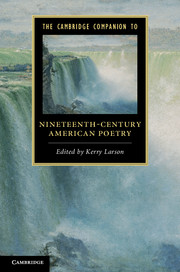Book contents
- Frontmatter
- Introduction
- I MANDATES, MOVEMENTS, AND MANIFESTOES
- 1 The reception of nineteenth-century American poetry
- 2 American Indian poetry in the nineteenth century
- 3 The poet as Poetess
- 4 Transcendentalist poetics
- 5 Slavery and its metrics
- 6 Weathering the news in US Civil War poetry
- 7 The “Twilight of the Poets” in the era of American realism, 1875–1900
- II INDIVIDUAL AUTHORS
- Selected guide to further reading
- Index
- Cambridge Companions to…
1 - The reception of nineteenth-century American poetry
from I - MANDATES, MOVEMENTS, AND MANIFESTOES
Published online by Cambridge University Press: 28 November 2011
- Frontmatter
- Introduction
- I MANDATES, MOVEMENTS, AND MANIFESTOES
- 1 The reception of nineteenth-century American poetry
- 2 American Indian poetry in the nineteenth century
- 3 The poet as Poetess
- 4 Transcendentalist poetics
- 5 Slavery and its metrics
- 6 Weathering the news in US Civil War poetry
- 7 The “Twilight of the Poets” in the era of American realism, 1875–1900
- II INDIVIDUAL AUTHORS
- Selected guide to further reading
- Index
- Cambridge Companions to…
Summary
If the pursuit of what an author “really” intended to convey in the words of a particular poem is a fascinating though frustrating task, the pursuit of what was understood by readers from some past moment and time – such as nineteenth-century America – is even more intriguing. Recently, scholars have turned to the question of how nineteenth-century Americans responded to the genre of poetry in order to resolve what, in conventional accounts, has seemed like a paradox: nineteenth-century Americans wrote and read poetry extensively and valued it highly but most of the poetry they wrote was judged by the twentieth-century to be inconsequential at best and ugly at worst. The rise of modernist aesthetics in the early twentieth century had so totally displaced what had come before that by mid-century even the names of many formerly important poets of the nineteenth century – especially the names of women poets – were forgotten. Even more forgotten was a sense of what readers had appreciated in the work of once famous poets such as Henry Wadsworth Longfellow or Lydia Sigourney. The New Criticism of the early part of the century and then the poststructuralist criticism of the last part of the century contributed to this, as they asked questions that nineteenth-century American poetry didn't seem to answer. But as scholars in the emerging fields of critical race studies and feminist studies started to search for, as Alice Walker puts it, “our mothers' gardens,” they inaugurated a broad-reaching reevaluation of nineteenth-century literary history.
- Type
- Chapter
- Information
- Publisher: Cambridge University PressPrint publication year: 2011
- 1
- Cited by



